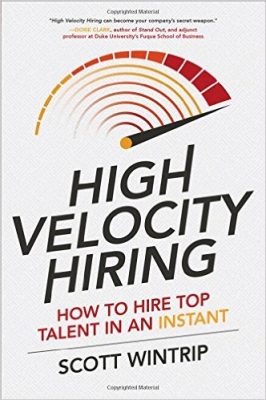 Author: Scott Wintrip
Author: Scott Wintrip
Publisher: McGraw-Hill Publishing – 272 pages
Book Review by: Sonu Chandiram
It has often been said by business speakers and business book authors that the most important asset of a company is its people. On the flip side, a bad hire could turn into a big liability. According to the Society of Human Resource Management, a hiring mistake could cost a company as much as five times the salary of a bad hire’s annual pay.
For this reason, the adage “slow to hire and quick to fire” has become popular. However, such a belief can and often does, have detrimental effects, points out Scotts Wintrip, a ‘hiring guru’ and author of this bestseller. This book which ranks a very high No. 234 in Amazon’s ‘Workplace Culture’ subgroup of Business Culture in the Business and Money category.
The ‘slow-to-hire’ approach often results in keeping a job open until the right person shows up. This can be very costly to a company. If it’s a sales position, that means lower sales and profits, or even loss of major or key customers. Also, managers’ focus or their objectives, or their entire departments’ lower morale can and often does have a financial impact on the company.
Wintrip. explains:
“In an organization, keeping a seat open is like an open wound. It’s a painful distraction that interferes with the business’s core mission. The department manager has to manage the extra workload. HR has to add one more task to its already overflowing plate. The talent acquisition team has to scramble to fill one more open job, made harder because of a skills shortage. With every passing day, overtime pay builds up, as do hiring costs.”
So what is the right way to hire, in order to avoid the costs of a bad hire, as well as avoid the financial costs and time costs (time = money) of having an open position for a long time, such as several months? The author provides the elements of a good and fast hiring system.
Wintrip has developed a method of hiring right, as well as hiring quickly, that he lays out in this book that can enable hiring executives and human resource managers avoid pain. In eleven chapters sandwiched between an Introduction that describes the problem and a Conclusion that summarizes the solution, he goes through the necessary details, as we outline for you below:
Introduction: Why Hiring Is Broken
- The Emperor Has No Talent: What Causes Long-time-to-fill
- The Talent Accelerator Process: Apply the Principles of the Go-Demand Economy to Fill Jobs in an Instant
- Step #1: Create Hire-Right Profiles: Design Blueprints Detailing Who’s Right for a Job
- Step #2: Improve Candidate Gravity: Generate a Continuous Flow of Quality Candidates
- Step #3: Maximize Hiring Styles; Leverage Perception to Counter Hiring Blindness and Support Accurate Employee Selection
- Step #4: Conduct Experiential Interviews: Employ Better Selection Methods to Improve Precision and Speed
- Step #5: Maintain A Talent Inventory: Create a Pool of People Ready to Hire
- Step #6: Keep the TAP Flowing: Ensure Hiring Can Always Be Done in an Instant
- Lean Recruiting: Deploy Automation to Enhance the Efficiency of your TAP
- Engage Talent Scouts: Create Lasting Partnerships Between Organizations and Staffing Providers
- Durable Diversity: Maintain a Dependable Workforce of Complementary People
Conclusion: A Rising Tide of Talent
This book provides the good balance needed between the extremes of hiring slowly but costing the company a lot, in terms of money and employee morale, and on the other hand, hiring quickly but getting bad hires that are costly to company.
This is a must-have and a keepsake for those who want to acquire valuable people fairly quickly and keep them for the long-term.
Author:
Scott Wintrip has changed the way leaders at hundreds of companies hire by helping them design and implement processes that allow them to hire the instant a job becomes open. Founder of the Wintrip Consulting Group, he is the acknowledged leader of the on-demand hiring movement. Wintrip is routinely a featured speaker at major conferences and frequently appears in leading publications.







